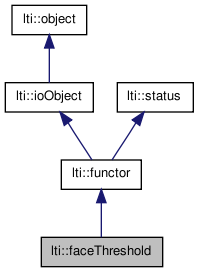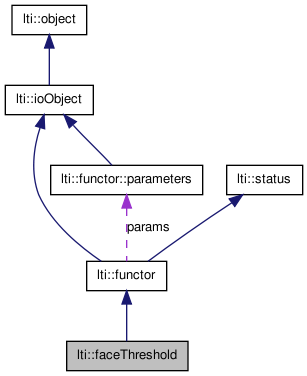

|
latest version v1.9 - last update 10 Apr 2010 |
|
The ltiFaceThreshold-class calculates for a given skin probability mask of an image an extraction-threshold that allows to 'cut-out' the face (blob) of the shown person. More...
#include <ltiFaceThreshold.h>


Classes | |
| class | parameters |
| The parameters for the class faceThreshold. More... | |
Public Member Functions | |
| faceThreshold () | |
| faceThreshold (const parameters &par) | |
| faceThreshold (const faceThreshold &other) | |
| virtual | ~faceThreshold () |
| virtual const char * | getTypeName () const |
| bool | apply (const channel &input, float &threshold) const |
| bool | apply (const channel &input, float &threshold, borderPoints &faceBlob) const |
| bool | apply (const channel8 &input, int &threshold) const |
| bool | apply (const channel8 &input, int &threshold, borderPoints &faceBlob) const |
| faceThreshold & | copy (const faceThreshold &other) |
| faceThreshold & | operator= (const faceThreshold &other) |
| virtual functor * | clone () const |
| const faceThreshold::parameters & | getParameters () const |
The ltiFaceThreshold-class calculates for a given skin probability mask of an image an extraction-threshold that allows to 'cut-out' the face (blob) of the shown person.
Depending on the apply()-method that is being called, the resulting face-blob is also returned.
In order to do so, a blob-ranking is performed, which can be done in two ways:
For every regarded threshold, all blobs (with size greater than a specified minimum) are extracted and then ranked considering the following criteria:
The result is the threshold that causes the blob with the highest score. For a detailed description of the functions that benchmark the above mentioned criteria see the individual parameters (lti::faceThreshold::parameters) that determine computation.
| lti::faceThreshold::faceThreshold | ( | ) |
default constructor
| lti::faceThreshold::faceThreshold | ( | const parameters & | par | ) |
Construct a functor using the given parameters.
| lti::faceThreshold::faceThreshold | ( | const faceThreshold & | other | ) |
copy constructor
| other | the object to be copied |
| virtual lti::faceThreshold::~faceThreshold | ( | ) | [virtual] |
destructor
| bool lti::faceThreshold::apply | ( | const channel8 & | input, | |
| int & | threshold, | |||
| borderPoints & | faceBlob | |||
| ) | const |
Apply.
| input | channel8 with the source data | |
| threshold | resulting threshold | |
| faceBlob | resulting face blob |
| bool lti::faceThreshold::apply | ( | const channel8 & | input, | |
| int & | threshold | |||
| ) | const |
Apply.
| input | channel8 with the source data | |
| threshold | resulting threshold |
| bool lti::faceThreshold::apply | ( | const channel & | input, | |
| float & | threshold, | |||
| borderPoints & | faceBlob | |||
| ) | const |
Apply.
| input | channel with the source data | |
| threshold | resulting threshold | |
| faceBlob | resulting face blob |
| bool lti::faceThreshold::apply | ( | const channel & | input, | |
| float & | threshold | |||
| ) | const |
Apply.
| input | channel with the source data | |
| threshold | resulting threshold |
| virtual functor* lti::faceThreshold::clone | ( | ) | const [virtual] |
returns a pointer to a clone of this functor.
Implements lti::functor.
| faceThreshold& lti::faceThreshold::copy | ( | const faceThreshold & | other | ) |
Copy data of "other" functor.
| other | the functor to be copied |
Reimplemented from lti::functor.
| const faceThreshold::parameters& lti::faceThreshold::getParameters | ( | ) | const |
returns used parameters
Reimplemented from lti::functor.
| virtual const char* lti::faceThreshold::getTypeName | ( | ) | const [virtual] |
returns the name of this type ("faceThreshold")
Reimplemented from lti::functor.
| faceThreshold& lti::faceThreshold::operator= | ( | const faceThreshold & | other | ) |